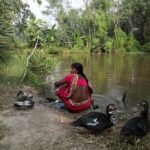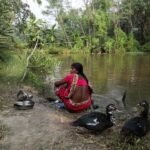Sundarbans, India – Panchanan Dolui, a resident of Mousuni Island in the Indian Sundarbans, has been forced to relocate three times due to floods and river erosion. With each move, Dolui has had to go further from the receding edge of the island to avoid displacement. He has witnessed vast areas of land being eroded by the river, leaving him and his community with nowhere else to go.
The Sundarbans forest system, located in West Bengal state in eastern India and neighboring Bangladesh, is a collection of low-lying islands and is the largest mangrove ecosystem in the world. It is home to several endangered species and serves as a natural barrier against cyclones, storm surges, and other environmental hazards. Additionally, the forests play a crucial role in carbon capture and sequestration.
However, the Sundarbans are facing rapid changes. The occurrence of four cyclones – Fani, Amphan, Bulbul, and Yaas – in the region from 2019 to 2021 highlights the increasingly unpredictable weather patterns caused by climate change and rising sea levels. As a result, the Sundarbans are becoming increasingly unsafe for human habitation, according to Kalyan Rudra, chairperson of the West Bengal Pollution Control Board.
The recent cyclones have worsened the climate-induced displacement that the people of the Sundarbans have been facing for decades. In 1996, Lohachara, one of the inhabited islands, disappeared under the sea, forcing residents to relocate to neighboring islands without proper documentation or property deeds. In response to limited livelihood options and insufficient development in the region, migration has become a coping strategy for many residents. There have been multiple waves of migration within the Sundarbans, often within the same island, to escape flooding and other natural disasters.
Since Cyclone Aila in 2009, economic vulnerability has driven distress migration, with men seeking informal work as migrant workers across India. Women-headed households are more common in the Sundarbans than in any other area of India due to distress migration. However, these households often face debt burdens, a high number of dependents, and limited livelihood opportunities.
In addition to displacement, the increasing salinity of the land in the Sundarbans is causing significant challenges. Salinity-resistant paddy farming has become popular as an adaptation strategy to climate change in the region. However, the rise in salinity has also led to commercial shrimp farming, resulting in land degradation. Women involved in prawn seed collection, which requires standing in saltwater for up to six hours, experience adverse health effects. Increased salinity has also severely degraded the mangrove ecosystem, impacting biodiversity and affecting the livelihoods of local communities.
The pressure on forest resources has also intensified human-animal conflicts in the Sundarbans. The area is home to “tiger widows,” women whose husbands were killed by tigers while fishing or collecting honey in the Sundarbans reserve. These deaths are not officially recognized, as entry into the forest is illegal for residents since it became a tiger reserve in 1973. The erasure of these deaths and the lack of official recognition make it challenging for the widows to access compensation and support.
Disaster relief efforts in the Sundarbans are often selective, favoring those with existing land holdings. This selective approach further exacerbates pre-existing vulnerabilities based on caste and gender. Erosion continues to pose challenges for officials determining suitable areas for the relocation of vulnerable residents. The erosion of shoreline in West Bengal has been the longest in India, with 63% erosion and the loss of 99 square kilometers of land from 1990 to 2016. The landless and marginalized residents of the Sundarbans, who live closest to the riverbanks, are the most affected by erosion.
While some areas in the Sundarbans show sediment build-up, providing possibilities for relocation, the rehabilitation of the entire population of over 4.5 million people is impossible. Moreover, since erosion will persist, relocation is not a sustainable long-term solution. The future of climate resilience in the Sundarbans remains uncertain due to the allocation and disbursement of funds being subject to political influences.
In December, Kolkata, the state capital, became one of the first claimants for climate change-induced loss and damage from the Loss and Damage Fund. The fund aims to provide coverage for climate-displaced populations from the Sundarbans. The National Disaster Management Authority has developed a draft policy covering coastal and river erosion, aiming to mitigate the impact and resettle those displaced by erosion.
However, the future of climate resilience in the Sundarbans depends on political dynamics. The contentious relationship between the central and West Bengal governments has affected the review of damage caused by Cyclone Yaas in May 2021. The allocation and disbursement of funds are critical for the implementation of effective climate adaptation measures.
As the Sundarbans grapple with the effects of climate change, the residents face a precarious future. Their lives and livelihoods are at stake as they confront the challenges of displacement, salinity, and erosion. The Sundarbans, once a thriving ecosystem, now stands on the brink of irreversible damage.




